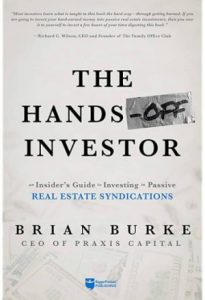Red Flags to Look for When Evaluating Passive Real Estate Syndication Investments
By Brian Burke, Author of The Hands-off Investor: An Insider’s Guide to Investing in Passive Real Estate Syndications
Looking at passive real estate syndication investment opportunities can make you feel like a long-tailed cat in a room full of rocking chairs. Let’s review some red flags that will help you evaluate opportunities faster and with more confidence.
Making the right investment decision is more important than ever. For the last twelve years, you could make a lot of mistakes and the continually ascending market would save you. But you can’t rely on that now—you need to spot the red flags before you invest, not after.
To make an investment in one of these deals, you must be able to trust three things. First, you must trust that real estate is where you want to invest your money. If you don’t, you probably wouldn’t be reading this article, and you probably wouldn’t be a member of AAOA, so it’s probably safe to assume this box is checked.
Second, you must trust the sponsor bringing you the investment opportunity. If you don’t think they are the right group to successfully oversee this venture and produce a favorable outcome, keep looking.
Third, you must trust the deal. If you don’t like the property, or the way the offering is structured, it’s a good idea to trust your gut and pass. There will be more opportunities later.
But how do you know if you should trust the sponsor or the numbers? Here are a few of the things to look for:
Sponsor Red Flags
- Lack of a track record. If this is the sponsor’s first deal, you might want to decide not to use your money for their training. Look for sponsors that have well-documented track records producing consistent results.
- Lack of market experience. If they have only done deals in one or two states, and now they are raising money for an acquisition across the country, be careful. Real estate is a local business, and you want your partners to be experts in the local market. This doesn’t mean they only invest in one market, but it does mean that experience in the market being contemplated is essential.
- Lack of product-type experience. Sponsors often specialize in a particular sector of real estate. If a group has only done industrial property, and now they are raising money to acquire a hotel, their experience might not be relevant to the new venture.
- Lack of full-cycle experience. This means, have they ever acquired, operated, and successfully sold an asset? This relates back to track record. You want a group that not only knows how to take off but also how to navigate and land. Oftentimes, newer groups only tout how many properties they’ve bought, and how many “doors” they own or manage, but are silent on how many they’ve sold.
- Lack of strategy experience. If you are being presented with a ground-up construction opportunity by a group that has only bought and operated completed projects, there could be bumps in the road.
- Lack of skin in the game. This doesn’t have to mean what you think. It’s not just whether the group’s principals are investing their own dollars alongside you. Even more importantly, do they have a reputation to protect? Have they built a brand that they cannot allow to fail? If not, they could abandon the deal, just to resurface later with a new logo and new name, to repeat their same mistakes with the next set of unsuspecting investors.
- Debt guarantors. Who is providing the guarantee on the debt (even if only a limited guarantee?) If an unrelated third party is providing this guarantee in exchange for a fee or some other compensation, such as a profits interest in the deal, and none of the sponsors principals are responsible for the guarantee, this points to the principals having less skin in the game. If the principals aren’t strong enough for their lender to trust them, it’s likely that you shouldn’t trust them either.
- Key person risk. One-person shops present the added risk that if something happens to the principal, there is no pilot left to fly the plane. You really don’t want to be a passenger on this flight.
- Poor quality investor reporting. Ask for samples of recent investor reports. After you see enough of them, you’ll easily recognize which groups put out thorough reports and which do not. Poor reporting can be more than just laziness, it could signal a lack of understanding or even mismanagement of the numbers.
Underwriting Red Flags
Probably one of the most common and easiest to spot underwriting red flags is a large increase in the first-year gross receipts projection as compared to the most recent historical 12 months. That is, immediately jumping the income forecast to new rents with no phase-in, which is simply impossible. You can spot this almost instantly if the offering materials show you the historical numbers. If they don’t show the historical numbers, that alone is cause for concern.
Here are a few more:
- Improper economic vacancy assumptions. Don’t believe that a 5% vacancy factor covers it all. There should be allowances for bad debt, concessions, model units, employee discounts for site staff, and leases that aren’t caught up to full market rent.
- Underestimated expense assumptions. This is most often seen as underestimated payroll expenses, repair/maintenance costs, and utilities expenses.
- Failure to properly account for property tax reassessment post-sale (in states that do this). Taxes paid by new owners are often higher than paid by the previous owners. But this is state-specific, so be sure to ask the sponsor about local procedure if you don’t see that they accounted for an increase.
- Improper use of cap rates and/or incorrect exit cap rate assumptions. Or failure to disclose the exit cap rate being used, or otherwise failing to show how they are arriving at a forecasted resale price.
- Basing exit prices on capitalized value of the income without accounting for the subsequent owner’s property tax reassessment. Future resale value is calculated using a function of the net income the next owner can expect. The next owner will have higher property taxes, just like what happened when the syndication group bought the property, if the local jurisdiction reassesses upon sale.
- Rent comps don’t support the projected rents, are cherry-picked to support improbable rents, or are missing entirely. Just like home values are established using comparable sales, rental rates are established using comparable rentals, and that data should be made available to you.
Offering Red Flags
There are nuances to the structure of each of these investments, not only between different sponsors but often among the same sponsor’s various offerings. It is important to review the offering documents and understand the investment structure. But these prospectuses aren’t always well constructed, or they can be unclear or simply carelessly drafted. Here are some things that should stand out as a problem:
- Offering documents loaded with spelling and grammatical errors. Sponsors will put their best foot forward when trying to get your money. If that’s the best they have, imagine how bad it gets later.
- Failure to account for all the costs incurred in putting together the offering, and to purchase real estate of this size—you should see these costs in the sources and uses of funds table. If the prospectus doesn’t disclose the sources and uses of funds, this in itself is a red flag.
- Failure to raise enough money to pay the down payment, closing costs, finance costs, syndication costs, immediate capital improvements, and still have enough money left over for capital reserves—see sources and uses of funds table to see where the money is going.
- Failure to show debt financing. They type of debt and the terms of that debt should be in the summary. If it’s not, that’s a problem.
- Using improper debt. The type of debt being used is extremely important. The use of high leverage can amplify returns, but it also amplifies losses. The more debt, the higher the risk. Today’s environment isn’t compatible with high risk from excessive debt. Look for offerings that are using a conservative level of financing with maturities out at least seven years.
- Incorrect or improper estimates of cash flow, cash-on-cash return, and IRR and/or a clear lack of understanding of those calculations and how to use them.
- Lack of waterfall calculations. These are the flow of funds estimates from the property level down to the investor and sponsor level, and show the breakout of what investors get and what the sponsor gets.
- Sponsor fees not factored into the sources and uses of funds, or in the expenses. We all know the sponsor is getting paid, and that’s fine. But they should show it, account for it, and factor it into the calculations of investor return.
- Business plan is not clear and well thought out. If you can’t figure out what the sponsor is proposing to do, it might be that they are unsure as well.
If done properly, investing in real estate syndications can be a safe way to invest and diversify your portfolio. Evaluating these investments, and more importantly, the group sponsors that are promoting them doesn’t have to be an overwhelming task. You can make it even less overwhelming by checking out my book, The Hands-Off Investor: An Insider’s Guide to Investing in Passive Real Estate Syndications. It is critical that you invest with the right syndication sponsors and in the right opportunities. This book will show you how to do both. Happy investing!
About the Author

 Brian Burke is President & CEO of Praxis Capital, Inc., a vertically integrated real estate private equity investment firm, which he founded in 2001. Brian is also a member of the Praxis Investment Committee. Praxis operates on multiple platforms, currently managing active syndications for the acquisition of single-family, multifamily, and opportunistic residential assets in US growth markets.
Brian Burke is President & CEO of Praxis Capital, Inc., a vertically integrated real estate private equity investment firm, which he founded in 2001. Brian is also a member of the Praxis Investment Committee. Praxis operates on multiple platforms, currently managing active syndications for the acquisition of single-family, multifamily, and opportunistic residential assets in US growth markets.
Over the course of a real estate investment career that began in 1989, the offerings Brian manages have acquired over 750 properties, including over 3,000 multifamily units, with the assistance of proprietary software that he wrote himself. Acquired asset classes include single-family homes, self-storage, mixed-use, and large apartment complexes in multiple states.















 Accessibility
Accessibility